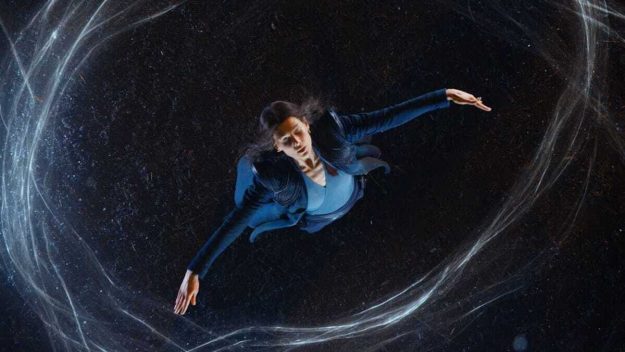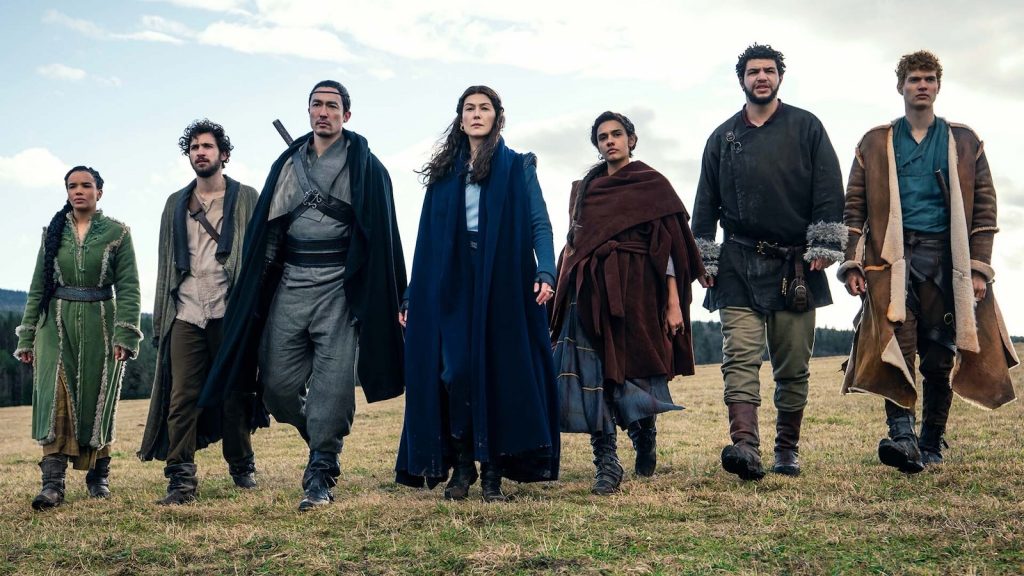Prime Video recently released the second season of Wheel of Time, a television series based on the vast fantasy world of Robert Jordan. The first season covers the first book in the series but also pulls in aspects from later books. Rebirth is an important component of the show.
Characters make frequent, even cynical references to the cycle of death and rebirth, while the book mentions the topic distantly and reverently. It is only referred to regarding the savior/destroyer of the world, who keeps being reborn, and the discovery of this character’s identity drives the plot. A character on the show says casually, “There is a wheel that spits out our lives,” in the midst of an everyday conversation. It’s as common a topic as the weather.
In addition to the wheel governing characters’ lives, there is a “pattern” made up of threads that dictate characters’ fates. Only one character, a seer, can see the pattern. She can tell by looking if someone is destined for great things or “important to the pattern.” Everyone is subject to the wheel of rebirth, but it seems not everyone is clearly a part of the pattern. The main characters on the show are, naturally, and part of the mystery is that you don’t know why they are important or what role they will play. Even the seer isn’t sure. (The seer is a moody character; a bartender and drinker. Seeing the innermost truth about people at a glance will do that to you.) The relationship between the wheel and the pattern is not made clear in the first season or book, but how they interact is apparently one of the saga’s major themes. (In the first episode of the second season a character muses about the wheel weaving, implying the wheel creates the pattern. Maybe.)
Richard Gombrich discusses belief in rebirth among Sri Lankan laypeople in his 1971 classic Buddhist Precept and Practice. His two categories of belief are affective and cognitive belief, with affective or conventional belief referring to the idea that personalities and memories transmigrate between lives, and cognitive belief referring to the more doctrinal notion of an impersonal karmic survival or continuation between lives. Wheel of Time seems to operate in this latter mode, and it’s key to the suspense. No one knows what their previous lives were; if they did, their paths would be much clearer.
It is accepted by all that time is a circle, that events that happened long ago will recur, and that the principal players will return to the stage to reenact the drama, but the outcomes are not necessarily predetermined.
The book series, begun in 1990, was planned at six volumes but eventually numbered fourteen, as well as a prequel and ancillary stories. Jordan died in 2007, before he could complete the work, and the final volumes were written by fellow fantasy author Brandon Sanderson, with the last one being published in 2013. I recently read the first volume, the 800-page Eye of the World, before watching the first season of the show. This to say that I’m no expert on Jordan’s world, which is huge and richly detailed. A reader of the entire series told me as much, saying that the first book (and TV series) is essentially a prologue with very little “real” information given, and that the story only gets going later.
Early episodes of the show lacked the urgency of the book, which may seem like an odd thing when comparing an enormous book to eight fifty-minute television episodes. The first episodes were painfully slow while tearing through the plot at a dizzying speed. Unpromisingly, showrunner Rafe Judkins made his entrée into the industry as a contestant on the 2005 season of Survivor. But things pick up later.
Wheel of Time premiered in 2021, roughly a year before Rings of Power, based on J. R. R. Tolkien’s Silmarillion—also a Prime Video production—and HBO’s House of the Dragon, the Game of Thrones prequel based on the work of George R. R. Martin. Both these series received a great deal of mainstream attention, positive and negative, while interest in Wheel of Time seemed limited to fans of the books. This comparatively narrow and passionate audience may explain why the first season received such harsh criticism. Though it failed to live up to the fandom’s demanding standards, the series was somehow renewed and Season 2 earned better reviews, and more viewers.
Rebirth as a fact of life comes up frequently on the show, and is accepted as a fact across all the cultures encountered in the world of Wheel of Time. Beyond this, as the name of the show implies, it is accepted by all that time is a circle, that events that happened long ago will recur, and that the principal players will return to the stage to reenact the drama, but the outcomes are not necessarily predetermined. Some change is possible, but it’s not clear how much. Jordan himself said in a 1998 interview that “Hindu mythology” informed his writing of the series as well as the concept of time as a circle, or wheel, and that the world of Wheel of Time was meant to be a mirror of our world:
I wanted the circularity because I wanted to go into the changes by distance. So the myths and legends and a few of the stories that these people tell, some of them are based on our current events, on the present. What they are doing is based on our myths and legends. So they are the source of our myths and legends, and we are the source of theirs.
I felt that because America is a melting pot, I had at least some right to mine the mythologies of any nation that is represented in the United States. And also religion. So there are elements that come out of religious books.
The wheel is a trap that forces the same conflicts again and again, and there is one person who seems to have the power to disrupt the cycle, but who is it?
The story begins, in classic Tolkienesque fantasy fashion, in a wholesome and bucolic village. A group of young friends prepares to celebrate a seasonal festival. (In the book they are teenagers, but on the show they are older, in their 20s.) A mysterious woman named Moiraine (played by Rosamund Pike) and her grim “warder,” a warrior named Lan (Daniel Henney), arrive, in search of someone born (or reborn) in this area. Shortly afterward, monsters called trollocs invade, burn the town down, and chase Moiraine and Lan and the friends out onto the road, in search of the far-off city where they will be protected. In the show, some of the group quickly (by the fifth episode) reach their destination. In the book, none of them do, but it doesn’t matter, because arriving at the destination only creates new problems.

Wheel of Time is full of magic and monsters, which isn’t for everyone, but the series is fairly restrained in both these areas. Only certain women, known as Aes Sedai, can “channel” magic. Moiraine is one of them. We learn that men used magic long ago but abused it somehow, and the power was taken away. As the show begins, this power shows signs of returning, and the Aes Sedai have been dispatched to contain the threat. Everyone, every villager and innkeeper on the show, knows that a person will someday be reborn who can use magic far more forcefully than anyone else, and they will be called the Dragon Reborn, after the ancient wizard who is said to have “broken the world.” A few “false dragons,” men using magic, are abroad in the land, causing trouble. (The Dragon himself can be seen on YouTube from an earlier attempt to film the series that was derailed for copyright issues. But it features the underappreciated Billy Zane.)
In the book, the Dragon Reborn can only be a man, or rather a boy. In the show, it is not known what form the reincarnated wizard will take. Though skeptics might see this as pandering to modern sensibilities of equity and representation, it greatly improves the story. The reincarnated soul may even be split among multiple people, one character suggests. In the novel, it is soon made clear to any reader paying attention who the chosen one is, but the show does a much better job at concealing this important point. The uncertainty gives greater opportunity for tension within the group, and the characters are often as confused as the viewer.
There’s a lot more to all this. There’s the Dark One, the satanic figure everyone is trying to defeat, who gives our heroes a lesson in impermanence (or is it just a threat?), saying, “Everything that means anything can be gone in an instant.” There are the Forsaken, powerful servants of the Dark One whose presence is barely hinted at in this season but whose role will loom ever larger. There is the Light, which is an undefined deity, or an aspect of the deity power. And there is the One Power, the source of Moiraine’s magic, and what the Dark One seems to draw on as well. Access to it appears to drive men mad.
Toward the end of the first season it is revealed that, at the Eye of the World, a place of great magical power that is crucial to the mission, the young people who are not the reincarnated Dragon will be killed. Moiraine demonstrates tremendous power, doing all sorts of wizardly things, but she is not omniscient. Her failure to detect the correct figure has potentially horrendous consequences for everyone around her, and as it turns out, it’s not so great for her either.
In the world of Avatar and Legend of Korra, another franchise with rebirth at its heart, reincarnation seems to be limited to the superpowered savior of the world, and it is easy to identify this figure because they display extraordinary powers at a young age. The extended Avatar universes also borrow the Tibetan tulku system’s use of identifying toys and ritual objects of the previous incarnation. Moiraine has only vague ideas to guide her to the one she seeks, and because she doesn’t know, she exposes innocent people to great danger. The one intimate relationship she is allowed is with her boss, which goes about as well as you might expect. Moiraine’s task is a painful and lonely one that ends with decidedly mixed results. But then again, when the wheel turns again, she may get another chance to do it a bit better.
Thank you for subscribing to Tricycle! As a nonprofit, we depend on readers like you to keep Buddhist teachings and practices widely available.
